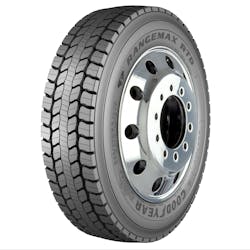Goodyear launches RangeMax tires for regional delivery vehicles
In anticipation of fleets using more electric vehicles in regional delivery, Goodyear has updated its Fuel Max line with a new name, RangeMax, and enhanced features to provide sustained performance on vehicles with different weight distribution and higher torque. According to the company, the RangeMax RSA ULT steer tire and RangeMax RTD ULT drive tire are the Akron-based tiremaker’s “best regional pickup and delivery tires for traction, range, and mileage, regardless of drivetrain.”
Available in sizes 225/70R19.5 and 245/70R19.5, the steer and drive tires will be suitable for appropriate Classes 3 to 5 vehicles regardless of if they refuel or recharge. This includes box trucks, step vans, and even Ford-450 and 550 chassis.
Both RSA and RTD have a Three-Peak Mountain Snowflake (3PMSF) traction rating to help with mud and snow. They are also GHG-2 certified
"Our latest RangeMax tires combine low rolling resistance with enhanced features like premium casings and long-lasting tread compounds to help increase vehicle uptime and protect fleets' investment,” said Rich Cottrell, senior director, Commercial Marketing, Goodyear North America.
How much the rolling resistance will impact range does depend on several factors, noted Dustin Lancy, Goodyear senior manager of marketing. These include road surface, weather, driving conditions, vehicle type, and route. Vehicles traveling more on highways would see a greater benefit than the start-stop conditions in urban environments, for example.
Depending on the region, a fleet may want to solely use the RSA, or complement with the RTD, which has a more “aggressive tread design” in the back.
“In Florida, you might run the RSA and all four positions , but if you're up here in Ohio, you might run the RSA in the steer in RTD in the drive,” Lancy said.
RangeMax RSA ULT
The all-position RSA (225/70R19.5.) is expected to have a 10% better rolling resistance over its predecessor, the Fuel Max RSA ULT, and utilizes Goodyear’s Intellimax Technology. As Lancy explains it, two small pieces of rubber built into the tread design provide reinforcement and more stiffness. That added stiffness balances out the higher torque at startup available to EVs, he said.
Read more: Goodyear's business deflation explained by tire industry expert
“If the tire has flex in it, that causes excess heat and scrub, which made the tire wear faster,” Lancy noted, which is a concern for the overall life of an EV's tires.
While Lancy noted “punching that gas pedal is really fun,” drivers who commonly do this also accelerate treadwear.
“Some of the OEMs are working to dial back some of that torque,” Lancy acknowledged.
He also explained that the placement of the battery on EVs may put more weight on the front tires, adding to the need for more stiffness.
To help with traction in mud and snow and increase range, the RSA also utilizes the “aggressive” Sawtooth Shoulder Groove Design and Advanced Tread Compounds. The tread evolves as it wears to offer reliable performance over the life of the tire.
The RSA's exact mileage is unknown at this point, with Goodyear planning to field test the tires with a EV OEM in the near future.
RangeMax RTD ULT
These drive tires offer a deep open-shoulder tread design for better traction, and also eschew petroleum for soy bean oil to provide sustainability benefits as well. Goodyear has now used this material on seven different tires.
This amounts to 4-5 oz. per tire for the RTD, though for a bus tire, that could amount to 16 oz.
“If you're a larger fleet that buys thousands of tires, that does add up to barrels and barrels of petroleum,” Lancy said.
“This is our first sustainable material that we've actually industrialized and are producing, and we're working on more types of materials like this to make more of these tires with more sustainable materials in the future,” Lancy added.
About the Author

John Hitch
Editor-in-chief, Fleet Maintenance
John Hitch is the award-winning editor-in-chief of Fleet Maintenance, where his mission is to provide maintenance leaders and technicians with the the latest information on tools, strategies, and best practices to keep their fleets' commercial vehicles moving.
He is based out of Cleveland, Ohio, and has worked in the B2B journalism space for more than a decade. Hitch was previously senior editor for FleetOwner and before that was technology editor for IndustryWeek and and managing editor of New Equipment Digest.
Hitch graduated from Kent State University and was editor of the student magazine The Burr in 2009.
The former sonar technician served honorably aboard the fast-attack submarine USS Oklahoma City (SSN-723), where he participated in counter-drug ops, an under-ice expedition, and other missions he's not allowed to talk about for several more decades.


